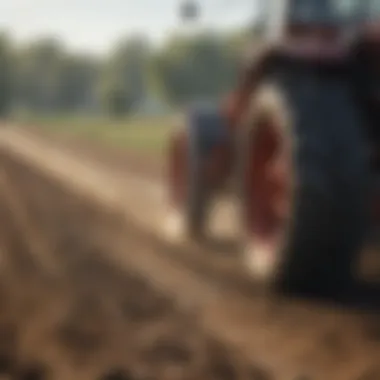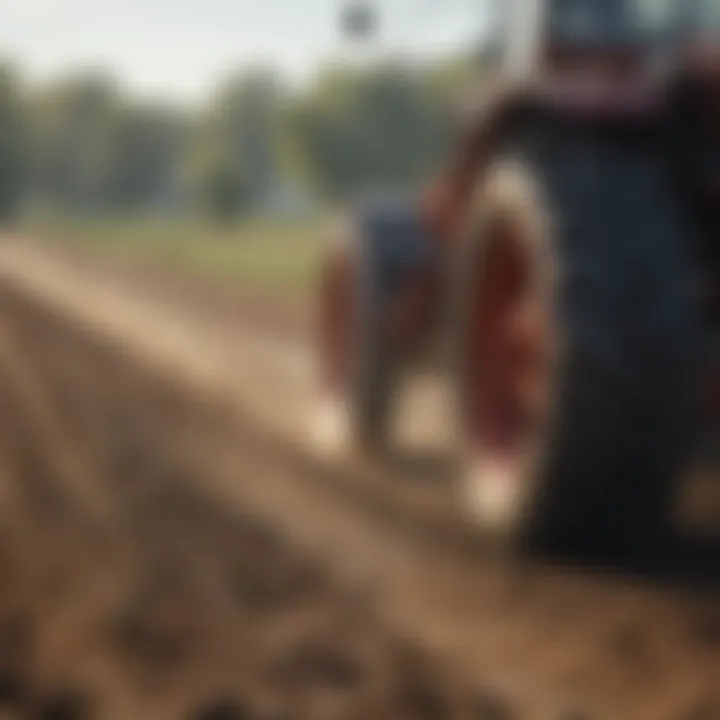Optimal Timing for Seed and Fertilizer Applications


Intro
Effective management of seed and fertilizer application timing is crucial for enhancing agricultural yield. Farmers must understand the factors that influence these timings, which include crop physiology, soil types, and weather patterns. Recognizing these elements can lead to optimal growth and productivity.
Overview of the Topic
Definition and Importance
Optimal timing refers to the most suitable period for sowing seeds and applying fertilizers to ensure plants receive the necessary nutrients at critical growth stages. This concept is fundamental for maximizing crop yields and improving economic outcomes.
Proper timing in seed and fertilizer application can significantly impact crop health. For instance, sowing seeds too early can result in poor germination due to cold soil, while late application of fertilizers might lead to nutrient leaching before crops can utilize them. Accurate timing has the potential to enhance resource efficiency and sustainability in farming practices.
Current Trends
Recent advancements in agriculture such as precision farming have influenced timing practices. Farmers leverage technologies like soil sensors and satellite imagery to make data-driven decisions about when to plant and fertilize. These innovations enable more precise applications, ultimately minimizing wastage of resources and maximizing productivity.
Key Techniques and Practices
Step-by-Step Guide
- Assess Soil Conditions: Before planting, conduct a soil test to understand nutrient levels and moisture. This information will guide fertilizer application rates and timing.
- Understand Crop Requirements: Different crops have distinct growing seasons and nutrient needs. Familiarize yourself with the specific requirements of each crop to schedule planting and fertilization accordingly.
- Monitor Weather Patterns: Regularly check weather forecasts to align planting and fertilization with optimal conditions. Avoid applying fertilizers during heavy rainfall to reduce runoff.
- Implement Crop Rotation: Rotate crops each season to balance nutrient demands and improve soil health. This practice can also disrupt pest cycles and reduce disease prevalence.
- Utilize Technology: Consider tools such as GPS-guided machinery and software that can optimize application rates and timing.
Tools and Equipment Needed
- Soil testing kits
- GPS-enabled planting equipment
- Fertilizer spreaders or applicators
- Weather monitoring devices
- Agricultural management software tools
Challenges and Solutions
Common Obstacles
Farmers face numerous challenges when determining the correct timing for seed and fertilizer application. These can include unpredictable weather, varying soil conditions, and the availability of resources. Additionally, farming practices that do not incorporate current knowledge can lead to poor outcomes.
Innovative Solutions
To navigate these challenges, farmers can adopt integrated farming practices that include:
- Real-time monitoring tools to assess weather and soil conditions.
- Collaborations with agricultural experts for advice on crop requirements and soil management.
- Participation in agricultural workshops and training programs to stay updated on best practices and technological advancements.
"The key to successful agriculture lies in understanding the complex interactions between soil, weather, and crop physiology."
By addressing obstacles and leveraging new technology, farmers can make informed decisions that enhance crop production and sustainability.
This comprehensive guide seeks to provide the insights necessary for making timely decisions in agricultural practices.
Preamble to Seed and Fertilizer Application
Farmers must recognize that seeds and fertilizers do not act in isolation. The success of crop growth hinges markedly on when and how these elements are applied. Proper timing can lead to enhanced growth, increased yields, and improved quality of the final product. In contrast, improper timing can result in wasted resources, minimal crop development, and environmental harm through runoff.
The right timing contributes to nutrient availability and seed germination. It enables farmers to align agricultural practices with natural environmental conditions. This synchronization is vital, especially as shifting climate patterns introduce new challenges to consistent agricultural productivity.
Importance of Timing in Agriculture
Timing in agriculture is paramount. Many factors dictate when seeds should be planted and fertilizers applied. Firstly, crops have specific physiological needs that vary throughout their growth stages. For instance, certain crops perform better when seeds are sown at specific soil temperatures. Fertilizer application must also coincide with critical growth phases when plants can utilize nutrients most effectively.
Moreover, incorporating local climate data can enhance timing decisions. Growing seasons can vary by region, and understanding local conditions helps tailor practices to ensure optimal plant health.
Farmers who pay attention to timing can avoid losses caused by adverse weather, such as heavy rainfall or drought, and leverage the seasonal patterns that favor crop development.
Overview of Seed and Fertilizer Types
An understanding of different seed and fertilizer types lays the foundation for effective application. Seeds come in numerous varieties, each genetically tuned to thrive under specific conditions. Choosing the right seed is the first critical step, as not every crop is suited for every environment.


Fertilizers can be categorized into various types such as organic and synthetic. Organic fertilizers, like compost or manure, release nutrients more slowly and improve soil structure. In contrast, synthetic fertilizers provide nutrients faster but require careful application to prevent nutrient leaching into the environment.
Adapting both seed selection and fertilizer type to local conditions maximizes resource use efficiency.
"Proper timing and choice of seed and fertilizer can transform a farm's productivity and sustainability."
Farmers must adopt an informed approach regarding what seeds and fertilizers to use. Practical knowledge about these products leads to greater efficiency and effectiveness in agricultural production.
Understanding Crop Lifecycles
Understanding crop lifecycles is crucial for optimizing seed and fertilizer application. Each crop goes through different growth stages, and awareness of these stages allows farmers to coordinate their inputs accordingly. This comprehension can lead to improved yields and effective use of resources. By aligning application timings with growth stages, farmers can provide plants with the necessary nutrients just when they need them the most.
The benefits of grasping crop lifecycles extend beyond just timing. It also helps in predicting potential challenges such as pests or disease during specific growth stages. For instance, knowing when crops are most susceptible can enable preemptive measures to protect the plants. Thus, understanding these aspects leads to a more holistic approach to agriculture, focusing not only on yield but also on the overall health of the ecosystem.
Growth Stages of Crops
Crops typically progress through several distinct stages: germination, vegetative growth, flowering, and maturity. Each stage has its unique characteristics that influence how crops develop.
- Germination: This is the initial stage where seeds sprout. Proper moisture and temperature are vital here to ensure successful emergence.
- Vegetative Growth: During this stage, plants grow in size and develop leaves. The focus is on establishing a strong root system and leafy canopy, essential for photosynthesis.
- Flowering: When plants enter the flowering stage, they prepare for reproduction. This is critical because it leads to fruit and seed production. Timing fertilization during this phase can significantly impact yield.
- Maturity: The final growth stage where crops reach their full size and begin ripening. Adequate water and nutrient availability is still crucial to ensure quality and readiness for harvest.
Awareness of how each crop behaves at these stages helps farmers to apply seeds and fertilizers at optimal times, ensuring plants receive the right nutrients when they need them the most.
Nutrient Requirements at Different Stages
As crops develop, their nutrient needs change significantly. Here is a brief overview:
- Germination Stage: During germination, seedlings require minimal nutrients, mostly reliant on the seed's stored energy.
- Vegetative Growth Stage: This stage demands high nitrogen levels to promote new leaf development. Farmers should consider applying nitrogen-rich fertilizers at this time.
- Flowering Stage: Phosphorus is crucial now as it supports blooming. Adequate phosphorus allows for better flower and fruit development.
- Maturity Stage: Potassium supports the overall health of the plant, influencing yield quality. Strategic application during this phase can enhance fruit quality and storage potential.
In summary, understanding crop lifecycles and their specific nutrient requirements can enhance the effectiveness of seed and fertilizer applications. This knowledge allows farmers to not only meet their crops' needs but also ensures sustainable agricultural practices.
Soil Health and Its Influence on Timing
Healthy soil promotes strong root development and improves water retention, which are crucial for successful seed germination. When the right conditions are met, plants can uptake nutrients more efficiently, leading to enhanced growth and productivity. Therefore, soil health should be a key consideration when scheduling applications.
Assessing Soil Composition
Determining the composition of soil involves analyzing its physical, chemical, and biological properties. The balance of sand, silt, and clay affects soil texture, which influences water retention and drainage capabilities. Additionally, chemical properties, such as pH levels, nutrient content, and organic matter, play a significant role in how well plants can utilize the soil's resources.
Farmers can use soil tests to evaluate nutrient availability and pH. Such tests provide information on the levels of nitrogen, phosphorus, potassium, and other essential nutrients, allowing for tailored amendment strategies. Notably, soil composition can change over time, necessitating regular assessments to inform application timings.
Impact of Soil Conditions on Application Timing
Soil conditions such as moisture levels, temperature, and texture can significantly impact the timing of seed and fertilizer application. For instance, wet soil can lead to the nutrient leaching, making it less effective when applied during heavy rain or extreme moisture conditions. On the other hand, dry soil may result in poor seed germination if seeds are planted too early in the season.
In areas with heavy clay, farmers may need to wait until the soil dries sufficiently to ensure proper equipment can operate without causing compaction. Similarly, sandy soils might require earlier planting since they warm up faster in spring. In brief, understanding specific soil conditions helps tailor application to prevent losses and improve efficiency.
Soil Testing and Analysis
Soil testing is a systematic approach to understanding soil health. Farmers should conduct soil tests at least every three years, or more frequently if significant changes occur. Collecting samples at varying depths will provide insight into how nutrients are distributed within the soil profile.
The analysis typically provides data on soil texture, pH, nutrient levels, and organic matter content. By interpreting these results, farmers can adjust their seed and fertilizer application strategies accordingly.
"Regular soil testing allows farmers to optimize their inputs, ensuring efficient use of fertilizers and enhancing crop performance."
In summary, farmers who pay close attention to soil health will benefit from improved timing for seed and fertilizer applications. By assessing soil composition, understanding its conditions, and conducting thorough testing, agricultural professionals can foster sustainable practices that lead to successful crop yields.
Climatic Factors Affecting Application Timing
Understanding climatic factors is crucial for optimizing seed and fertilizer application. These factors influence the growth and development of crops significantly. Temperature, rainfall patterns, and seasonal variations dictate when farmers should apply seeds and fertilizers. Effectively managing these aspects can help in achieving higher yields and better crop quality.
Impact of Temperature on Germination and Growth
Temperature plays a vital role in the germination and growth of crops. Specific crops have temperature ranges within which they thrive. For example, some vegetables like lettuce prefer cooler temperatures, while others such as tomatoes need warmer conditions. If seeds are planted too early or too late, the temperature may not be conducive for germination, leading to poor growth.


- High temperatures can cause rapid soil evaporation. This can lead to drought stress in crops, even if there is sufficient moisture in the soil.
- Conversely, low temperatures can delay germination and mock the growth process. During this time, the plants may be more susceptible to diseases.
Monitoring temperature forecasts can guide farmers in determining the best time for planting. By aligning seeding times with optimal temperature ranges, they can improve germination rates and stronger plants.
Rainfall Patterns and Their Implications
Rainfall is another element that significantly impacts seed and fertilizer application. The availability of water affects soil moisture content and crop health. Irregular rainfall patterns can create challenges, such as either drought or excessive moisture, both detrimental to crop success.
- Sufficient rainfall during and after seed planting supports better germination and growth.
- In contrast, excess rain can lead to flooding, disrupting seeds and fertilizers in the soil, which may lead to nutrient runoff. This not only wastes the efforts of the farmers but also affects soil quality.
To manage these challenges, farmers should analyze historical rainfall data and consider seasonal forecasts. This approach allows better planning around planting schedules and fertilizer applications to mitigate risks.
Seasonal Considerations for Different Regions
Different regions experience varying climatic conditions. This diversity necessitates that farmers adapt their practices based on regional shifts in seasons. Each crop has particular seasonal preferences. For instance, some grains may perform better in cooler climates, while others may require warm seasons for optimal growth.
Being aware of the local climate and its seasonal patterns can:
- Encourage proper seed and fertilizer applications aligned with local weather conditions.
- Reduce the risk of losses due to unexpected weather events.
- Help in timely harvesting, ensuring crop maturity coincides with favorable weather.
"Understanding your local climate is key to maximizing agricultural productivity."
In summation, climatic factors are paramount in determining the timing for seed and fertilizer application. The knowledge of how temperature, rainfall, and seasonal patterns affect these activities can ultimately optimize crop growth and sustainability, leading to enhanced agricultural success.
Best Practices for Seed Application
Effective seed application is central to the agricultural success of any farm. The timing and method of applying seeds can significantly influence crop yields and sustainability. Understanding best practices allows farmers to make educated decisions that improve planting outcomes. The aim is to create conditions that foster germination and establish robust plants. This section covers the timing recommendations for various crops and the methods that ensure efficient seed placement.
Timing Recommendations for Various Crops
Timing seed application is not just about the planting date. It involves understanding the specific needs of different crops. For instance, corn seeds thrive with warmer soil temperatures. Planting should ideally start when soil temperature reaches around 50°F (10°C). In contrast, wheat germination occurs best in cooler conditions, making late fall or early spring a preferred timing.
On the other hand, soybeans prefer later planting dates as they establish better with increased soil warmth and moisture. This variable timing can greatly impact the crop's growth and eventual yield.
Some factors to consider when determining the best timing include:
- Local climate conditions: Understanding the microclimate of the specific farm area can guide the planting dates.
- Soil moisture levels: Ensuring the soil is adequately moist before planting can encourage better seed germination.
- Pest pressure: Early planting can lead to higher pest incidence. Assessing pest forecasts may be integral in deciding when to plant.
- Frost potential: Knowing frost dates is crucial, especially for tender crops.
"Optimal timing for seeding results in improved germination rates, leading to greater overall yields and sustainability."
Methods for Efficient Seed Placement
The technique of seed application considerably impacts crop performance. Efficient seed placement can reduce seed waste, optimize moisture retention, and improve nutrient access. There are multiple methods available.
One effective method is drilling, where seeds are planted in rows at the proper depth and spacing. This approach fosters even germination and growth, allowing plants to compete effectively for resources. Alternatively, broadcasting seeds across the field can be practical in some settings. This method, however, may require careful follow-up to ensure seeds are adequately covered and protected from the elements.
Incorporating precision agriculture technologies can also enhance seed placement. GPS-guided planting equipment can help ensure that seeds are planted at optimal depth and spacing, increasing their chances of successful germination. Using sensor technology to monitor soil conditions in real time allows for timely adjustments that can further enhance seed performance.
Best Practices for Fertilizer Application
Fertilizer application practices are crucial to agricultural productivity. They ensure crops receive the right nutrients at the right times. Optimal practices not only improve crop yield but also protect the environment. Farmers must consider several elements to enhance their fertilizer strategies. These include understanding fertilizer types, their release patterns, and the specific timing needed for application based on various factors.
Types of Fertilizers and Their Release Patterns
There are multiple types of fertilizers, each with distinct release patterns and mechanisms. Farmers primarily focus on three categories: organic fertilizers, synthetic fertilizers, and slow-release fertilizers.
- Organic Fertilizers: These are derived from natural sources, such as manure, compost, and bone meal. They provide nutrients slowly as they decompose, encouraging healthy soil ecosystems.
- Synthetic Fertilizers: Manufactured chemically, these fertilizers act quickly, delivering nutrients like nitrogen, phosphorus, and potassium directly to plants. However, they may also increase the risk of leaching if not timed properly.
- Slow-Release Fertilizers: These fertilizers are designed to release nutrients gradually over time. This is beneficial for extending nutrient availability for crops while reducing the risk of over-fertilization.
Understanding the differences in nutrient release can guide decisions on when and how to apply these fertilizers.
Optimal Timing for Different Fertilizer Types
The timing of fertilizer application can significantly influence plant growth and soil health. Here are key considerations for different fertilizer types:


- Organic Fertilizers: These should generally be applied before seeding or during early growth stages. The slow nutrient release aligns well with the needs of developing plants. This timing also allows microbial activity to enhance nutrient cycling in the soil.
- Synthetic Fertilizers: Timing is critical for synthetic fertilizers to maximize efficiency. Application is often recommended at planting time and then again during critical growth phases, such as flowering and fruit formation.
- Slow-Release Fertilizers: These can be applied at the beginning of the growing season. Their design allows nutrients to be accessible throughout the growth stages. Farmers can reduce the need for additional applications, making this method both efficient and cost-effective.
Properly timing fertilizer application is essential for maximizing yield and ensuring environmental integrity.
In summary, adopting best practices for fertilizer application can lead to better crop outcomes. By understanding different fertilizer types and timing their application accordingly, farmers can make informed decisions. This careful approach contributes to sustainable farming practices and improved agricultural productivity.
Monitoring and Adjusting Application Strategies
Monitoring and adjusting application strategies for seed and fertilizer are crucial components in modern agriculture. The dynamic nature of farming necessitates that farmers not only apply their inputs correctly but also be vigilant in observing the outcomes of those applications. This approach allows for timely adjustments which can significantly enhance crop yields.
By effectively monitoring the growth and health of crops, farmers can gain insights into the efficiency of their practices. This includes tracking the germination of seeds, nutrient absorption rates, and even pest pressures. Adjusting strategies based on this feedback allows for targeted interventions, which can reduce waste and maximize productivity.
Role of Technology in Precision Agriculture
Technology plays a transformative role in the realm of precision agriculture. Tools such as satellite imagery, drones, and mobile applications offer farmers the ability to gather real-time data about their fields. This data can be analyzed to inform decisions regarding seed and fertilizer application timing. For instance, drones can provide detailed aerial views of crop health, indicating where extra nutrients may be necessary.
With the advent of precision farming methods, farmers can implement variable rate application techniques. This practice allows for more precise targeting of inputs based on specific field conditions. As a result, farmers can optimize resource usage, which leads to cost savings and environmental benefits. The integration of technology in monitoring establishes a feedback loop where adjustments can be made continuously.
Continuous Soil and Crop Monitoring
Continuous monitoring is essential to maintaining the health of crops and soil. Soil qualities can change due to a variety of factors, including moisture levels, temperature variations, and nutrient depletion. By regularly testing soil properties, farmers can better understand when and how much fertilizer to apply. This continuous approach also aids in identifying crop stress before it becomes apparent.
Sensors placed in fields can track moisture levels, temperature, and nutrient content at various depths. Data gathered can help farmers make decisions about irrigation and fertilization proactively rather than reactively. This method not only improves the health of the crop but also ensures that resources are used efficiently.
In essence, the integration of monitoring technologies and practices creates an adaptive farming environment. It allows for more informed decision-making and ultimately leads to healthier crops and improved yields. As farmers embrace these strategies, they can significantly enhance their efficiency and sustainability in agricultural practices.
"Effective monitoring leads to better decision-making in agriculture, ultimately improving yield and sustainability."
The future of agriculture lies in a blend of traditional knowledge and modern technology. By continually refining their strategies, farmers can adapt to changing conditions and meet the demands of a growing population.
Consequences of Improper Timing
Understanding the consequences of improper timing for seed and fertilizer application is critical for any agricultural practice. This aspect directly affects a farmer's ability to achieve optimal crop yield and ensure environmental sustainability. Misjudgments in timing can lead to decreased crop performance and negative long-term effects on soil and local ecosystems. By recognizing the implications, farmers can adjust their strategies to mitigate risks associated with poor timing.
Impact on Crop Yield and Quality
Timing is essential for both seed and fertilizer application. Seeds sown too early or late can face adverse weather conditions, leading to poor growth or failure to germinate. For example, chilly nights can delay germination rates significantly. Fertilizer applied at the wrong time may not provide the nutrients needed during critical growth phases, reducing overall yield. When nutrients are available at the wrong time, plants may experience nutrient deficiencies, affecting their health, size, and ultimately, their quality. It is thus vital to synchronize application schedules with the crop's developmental stages.
- Nutrient Timing: Nutrients needed during early growth differ from those required during flowering or fruiting. Fertilizing in line with plant needs can prevent nutrient lockout and ensure proper uptake.
- Crop Management: Delayed planting can lead to smaller plants that are less resilient to pests and diseases. Such plants may also produce lower-quality produce, affecting marketability.
Research shows that crops given optimal nutrition at their peak demand times can yield up to 15-20% more compared to those that are not properly nourished during critical stages.
Environmental Considerations and Sustainability
Applying seeds and fertilizers at the wrong time can have severe effects on the environment. When fertilizers are applied before heavy rain, there is a higher risk of runoff into local waterways. This can lead to nutrient pollution, causing issues like algal blooms, which oxygen depletion in water bodies affects aquatic life.
Moreover, improper timing can degrade soil health. Repeated cycles of misapplication may result in nutrient imbalances, promoting the leaching of essential minerals from the soil.
- Runoff Prevention: Careful scheduling of application reduces the risk of fertilizers washing away, promoting water quality.
- Soil Integrity: Well-timed fertilization and planting help in building soil structure, supporting beneficial microorganisms. This contributes to long-term soil fertility and sustainability.
To safeguard both crop yield and the environment, it is crucial for farmers to adopt techniques and tools that assist in precise timing. Leveraging data from weather predictions and soil health assessments can support better decision-making. This is advantageous not just for the current crop cycle but lays down a foundation for sustainable farming practices in the future.
Summary and Future Directions
Farmers and agricultural professionals must constantly adapt their strategies based on a variety of factors. As changes in climate impact crop cycles and nutrient needs, staying informed about these shifts is crucial. The importance of this topic cannot be overstated; effective timing translates directly into enhanced yields and reduced environmental impacts. It remains essential to balance immediate crop needs with long-term soil health.
Key Takeaways for Farmers and Professionals
- Understanding Crop Requirements: Each crop has specific growth stages with unique nutrient requirements. Farmers should tailor their applications based on the individual needs of the plants.
- Soil Testing: Regular soil testing provides insight into nutrient availability and deficiencies, allowing for precise timing in both seed and fertilizer applications.
- Weather Patterns: Knowledge of local climatic patterns helps predict suitable times for application. This can involve adjusting timings based on forecasts of rainfall and temperature.
- Technological Advances: The use of precision agriculture tools can enhance the timing of applications. This technology provides real-time data that supports informed decision-making.
- Economic Impact: Proper timing not only improves yields but can also reduce costs through more efficient use of resources.
Promising Research and Innovations
The future of agricultural practices promises new technologies and research that could further refine the timing of seed and fertilizer applications. Some noteworthy innovations include:
- Drones and Satellite Imagery: These technologies allow farmers to monitor crop health from above, helping them decide the optimal times for application based on real-time data.
- Soil Sensors: New sensor technologies can provide immediate feedback on soil conditions, enabling farmers to align their applications accurately with crop needs.
- AI and Machine Learning: These emerging fields can analyze patterns in crop growth and environmental conditions, suggesting optimal application timings for different scenarios.
- Sustainable Practices: Research into organic and slow-release fertilizers offers new ways to improve efficiency and minimize the negative impacts on soil health and the environment.
"The integration of technology not only supports better timing but also ensures that agricultural practices remain sustainable amid changing environmental conditions."
Investing in these areas will not only address current agricultural challenges but also promote a more sustainable future for farming practices.



